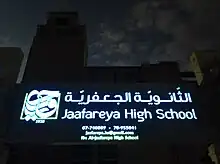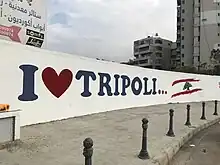English language in Lebanon
English is a secondary language of Lebanon, with 40% of the population saying in 2011 that it can speak it non-natively.[1]
Most Lebanese people speak Lebanese Arabic, also known as Lebanese. English, however, is also used in Lebanon for a variety of functions, including oral and written communications, sometimes among speakers of Lebanese.[2] It is also used as a medium of instruction, especially in natural sciences and mathematics.
Many Lebanese words, such as CD, crispy, hot dog and film, have been borrowed from English, and some speakers code-switch between English, Lebanese, and French in a single conversation, such as in the common greeting "hi, كيفك (kīfak)? Ça va?"
History

Because of the French Control of Lebanon from 1918 to 1946, Lebanon has had many Lebanese people who are fluent in French[3] and the government often writes in French alongside Modern Standard Arabic (MSA).[2]
Despite that, English grew in Lebanon in the wake of American influence through oil and business interests in the Middle East.[4] In 1972, 54% of Lebanese people said they speak French or English, and 75% of Beirutis. Of Beirut's bilingual population, 48.5% spoke French and 26% spoke English.[4]
Many of the Palestinians in Lebanon were also fluent in English.[4]
In 2011, 40% of Lebanon's population said that they spoke English non-natively.[1]
Education
In most schools and universities, MSA is considered secondary and is only taught as a subject.[5]
Schools

Between 1994 and 1997, the Council of Ministers passed a new National Language Curriculum that required schools to teach MSA while also using either English or French in natural sciences and mathematics.[2][6] In general, school students are exposed to two or three languages.[7]
In 2009, the Lebanese Education Ministry reported that the number of students learning French as a second language had fallen by over 10% while the number of students learning and using English keeps increasing.[8]
Higher education
The American University of Beirut (AUB) was founded in 1866, though English only overtook MSA as the main language of instruction from 1875 onwards.[2] Out of the 28 private universities that mushroomed between 1990 and 2021, 25 use English as a medium of instruction.[5]
Media
The Daily Star (1952–2021) was an English-language newspaper in Lebanon.[2]
Social significance
The use of English in daily life of Lebanese people reflects a desire for "modernity, coolness, and hip culture".[2] It is also a reaction to the negativity associated with Arabic since the September 11 attacks.[2] Many businesses advertise in English.[2]
English's impact on Lebanese Arabic
Borrowed words
Lebanese Arabic has borrowed many terms from English.
| Theme | Some borrowed words[2] |
|---|---|
| General | film, video clip, data, club, kilometer, kilogram, credit card, visa, bank |
| Shopping | jeans, mall, T-shirt, boots, sandals, uggs, sale |
| Travel | ticket, cruise, checkin, checkout, hotel, transit, boarding, gate |
| Sports | football, goal, penalty, tennis, volleyball, basketball, gym, dunk |
| Technology | internet, website, link, laptop, mouse, CD, disc, keyboard, hard drive, tablet, scanner, printer, phone, DVD |
| Food | diet, hamburger, hot dog, ketchup, fries, mayonnaise, ranch, crispy, wings, coke, beer, ice cream, pub, café, cafeteria, snack |
Additionally, some English verbs have been borrowed and altered to follow the syntax of Levantine Arabic. For example, shayyik comes from the English word check, and sayyiv comes from the English word save.[2]
Code-switching
Code-switching (alternating between languages in a single conversation) between Lebanese, French, English,[7] and MSA is so common in Lebanon, often being done in both casual situations and formal situations like TV interviews.[9] This prevalence of code-switching has led to phrases that naturally embed multiple linguistic codes being used in everyday language, like the typical greeting "hi, كيفك (kīfak)? Ça va?", which combines English, Lebanese, and French.[10][11][3]
References
- Euromonitor International report (2011)
- Esseili, Fatima (2017). "A sociolinguistic profile of English in Lebanon". World Englishes. 36 (4): 684–704. doi:10.1111/weng.12262. ISSN 1467-971X. S2CID 148739564.
- "In polyglot Lebanon, one language falls behind: Arabic". The Independent. 2010-03-02. Retrieved 2023-08-28.
- Times, Juan de Onis Special to The New York (1973-03-25). "English Is Steadily Overtaking French in Lebanon as the Second Language". The New York Times. ISSN 0362-4331. Retrieved 2021-06-25.
- Nicolas, Maureen O'Day; Annous, Samer (June 2021). "The Realities of English Medium Instruction in Lebanon: Teachers' and Students' Perceptions of the Place of English Communication Skills in a Cultural Studies Program". Journal of English as an International Language. 16 (1): 10–24. ISSN 1718-2298.
- "Lebanon - Educational System—overview". education.stateuniversity.com. Retrieved 2023-08-28.
- Bahous, Rima N.; Nabhani, Mona Baroud; Bacha, Nahla Nola (2014-10-02). "Code-switching in higher education in a multilingual environment: a Lebanese exploratory study". Language Awareness. 23 (4): 353–368. doi:10.1080/09658416.2013.828735. ISSN 0965-8416.
- "English Is The New French: The Case Of Lebanon". The Friday Times. 2022-09-08. Retrieved 2023-08-30.
- Behnstedt, Peter (2011). "Syria". In Edzard, Lutz; de Jong, Rudolf (eds.). Encyclopedia of Arabic Language and Linguistics. Brill. doi:10.1163/1570-6699_eall_EALL_COM_0330.
- Bizri, Fida (November 2013). "Linguistic Green Lines in Lebanon". Mediterranean Politics. 18 (3): 444–459. doi:10.1080/13629395.2013.834568. ISSN 1362-9395.
- "In polyglot Lebanon, some fear Arabic language is losing ground". Associated Press. 2015-03-27. Retrieved 2023-08-28.
